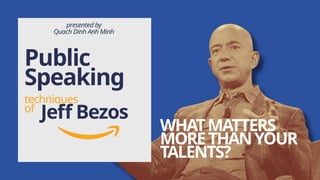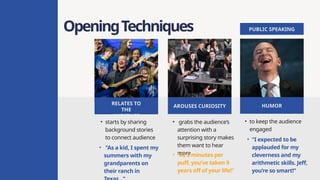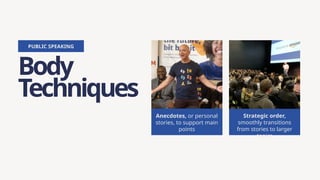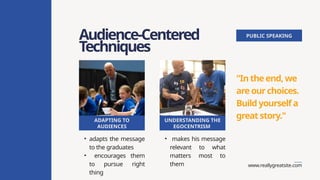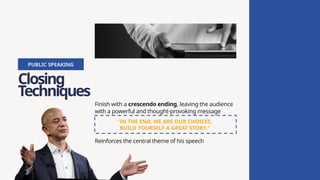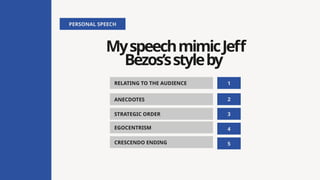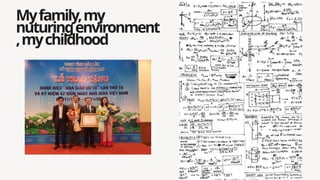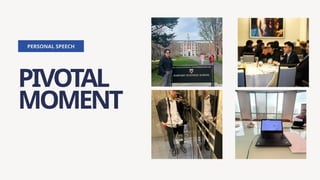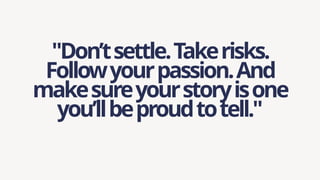Public speaking technique from Influencer
- 1. Public Speaking techniques of WHATMATTERS MORETHANYOUR TALENTS? Jeff Bezos presented by Quach Dinh Anh Minh
- 2. OpeningTechniques ŌĆó starts by sharing background stories to connect audience RELATES TO THE AUDIENCE AROUSES CURIOSITY HUMOR ŌĆó "As a kid, I spent my summers with my grandparents on their ranch in ŌĆó grabs the audienceŌĆÖs attention with a surprising story makes them want to hear more ŌĆó "At 2 minutes per puff, youŌĆÖve taken 9 years off of your life!" ŌĆó to keep the audience engaged ŌĆó "I expected to be applauded for my cleverness and my arithmetic skills. Jeff, youŌĆÖre so smart!" PUBLIC SPEAKING
- 3. Body Techniques PUBLIC SPEAKING Anecdotes, or personal stories, to support main points Strategic order, smoothly transitions from stories to larger topics
- 4. www.reallygreatsite.com Audience-Centered Techniques PUBLIC SPEAKING ADAPTING TO AUDIENCES UNDERSTANDING THE EGOCENTRISM "In the end, we are our choices. Build yourself a great story." ŌĆó adapts the message to the graduates ŌĆó encourages them to pursue right thing ŌĆó makes his message relevant to what matters most to them
- 5. Closing Techniques Finish with a crescendo ending, leaving the audience with a powerful and thought-provoking message "IN THE END, WE ARE OUR CHOICES. BUILD YOURSELF A GREAT STORY." Reinforces the central theme of his speech PUBLIC SPEAKING
- 7. MyspeechmimicJeff BezosŌĆÖsstyleby PERSONAL SPEECH RELATING TO THE AUDIENCE 1 2 3 EGOCENTRISM 4 CRESCENDO ENDING 5 ANECDOTES STRATEGIC ORDER
- 9. Flashback... APRIL 30TH PRIZES HIGH SCHOOL FOR THE GIFTED
Editor's Notes
- #1: Hello everyone, today IŌĆÖm going to talk about the public speaking techniques Jeff Bezos - the founder of Amazon applied in his commencement speech at Princeton University. In his speech, titled "What Matters More Than Your Talents", delivered in 2010, Bezos shared life lessons about the importance of choices over innate talents. He encouraged graduates to focus on building a meaningful life story through their decisions, emphasizing kindness and passion. Bezos delivered a powerful message to graduates, and he used a variety of effective techniques to capture their attention and make his message memorable. IŌĆÖm going to break down these techniques and explain how they work to make his speech so impactful.
- #2: LetŌĆÖs begin with the opening techniques. First, he relates to the audience. Bezos starts by sharing stories from his own childhood, particularly his summers with his grandparents. By doing this, he connects with the graduates on a personal level. He doesnŌĆÖt just talk about himselfŌĆöhe talks about something that many people can relate to, like family and travel. Next, he arouses curiosity. He talks about how he calculated how many years his grandmother might lose by smoking. This unexpected story catches the audience off guard and makes them want to hear more. Then, Bezos uses humor to keep the audience engaged. He talks about how he expected his grandmother to praise him for his clever math skills, but instead, she starts crying. This moment adds humor to the speech while also teaching a valuable lesson about kindness over cleverness.
- #3: Now, letŌĆÖs take a look at the body of the speech and how Bezos organizes his ideas. Bezos uses anecdotes, or personal stories, to support his main points. The story about his grandmotherŌĆÖs reaction to his "math" is a great example. It had succeed in make his message more relatable and memorable. He also uses strategic order in the way he presents his ideas. After talking about his childhood, he smoothly transitions to larger topics, like the importance of following your passion and making choices. This natural flow helps the audience follow his message clearly.
- #4: One of the most powerful aspects of BezosŌĆÖs speech is how he focuses on the audience. He adapts his message to the graduates, understanding that they are at a turning point in their lives. They are about to start a new chapter, and he encourages them to make choices that will shape their future. Bezos also understands the egocentrism of his audienceŌĆögraduates are naturally thinking about their own lives and what lies ahead. So, he makes his message relevant to what matters most to them.
- #5: Finally, letŌĆÖs look at how Bezos ends his speech. He finishes with a crescendo ending, leaving the audience with a powerful and thought-provoking message: "In the end, we are our choices. Build yourself a great story." He also reinforces the central theme of his speech. By reminding the graduates that their choices will define their lives, Bezos brings everything together and ends on a high note.
- #10: Now, letŌĆÖs take a look at the body of the speech and how Bezos organizes his ideas. Bezos uses anecdotes, or personal stories, to support his main points. The story about his grandmotherŌĆÖs reaction to his "math" is a great example. It had succeed in make his message more relatable and memorable. He also uses strategic order in the way he presents his ideas. After talking about his childhood, he smoothly transitions to larger topics, like the importance of following your passion and making choices. This natural flow helps the audience follow his message clearly.
